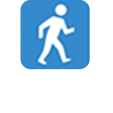 Consumers who patronize Walgreens can get rewarded for tracking their physical activity For the Steps with Balance program kickoff, self-tracking consumers can earn 20 points for every mile walked or run and 20 points for tracking weight.
Consumers who patronize Walgreens can get rewarded for tracking their physical activity For the Steps with Balance program kickoff, self-tracking consumers can earn 20 points for every mile walked or run and 20 points for tracking weight.
Walgreens implemented the Walk with Walgreens program in 2012. The program won an Effie Award for an outstanding marketing program. With the success of Walk with Walgreens, the retail pharmacy company has expanded the program beyond simple steps to include weight tracking and health goals for earning loyalty points.
 The program enables a few of the most popular self-tracking devices to sync so that consumers can avoid the dreaded self-entry of data. Devices acceptable today include the Fitbit Zip, Ultra or One; Withings Wi-Fi Body Scale; and, BodyMedia CORE and LINK. Here is a link to the My Devices page to see details on linking these tools. I added three of these tools that I regularly use, and the process was pleasantly painless.
The program enables a few of the most popular self-tracking devices to sync so that consumers can avoid the dreaded self-entry of data. Devices acceptable today include the Fitbit Zip, Ultra or One; Withings Wi-Fi Body Scale; and, BodyMedia CORE and LINK. Here is a link to the My Devices page to see details on linking these tools. I added three of these tools that I regularly use, and the process was pleasantly painless.
The loyalty program offers several ways to add points to an account beyond physical activity tracking in the Steps with Balance program. Loyalty program members can also earn points spending money on weekly advertised products, found on the loyalty points page of the Walgreens website; prescription drug fills earn points, as well as immunizations received at the store. Furthermore, AARP members also receive additional rewards by linking a AARP membership number to the Balance rewards account.
Walgreens is the largest pharmacy chain in the U.S.

Health Populi’s Hot Points: Retail loyalty programs are going way beyond earning points for simple cash spending, and this is a good thing for health. Rewarding people based on healthy activities is a welcome innovation in retail health, part of HealthcareDIY for consumers who want to more deeply engage in improving their own health. Bolstering healthy behaviors with rewards creates a virtuous cycle which, in the case of Walgreens’ Steps for Balance program, can be a win-win for both the pharmacy chain and the consumer.
The larger issue here is the role of the retail pharmacy in peoples’ everyday health. Retail pharmacies are close-at-hand, geographically, to most Americans. It’s not uncommon to find two competing brand pharmacy storefronts across-the-street from each other in urban and suburban locales. Competing for loyalty isn’t done out of the collective good of pharmacies’ hearts: getting consumers to spend in the front of the store and not only in the pharmacy drives profitability.
Pharmacies are increasingly playing a role in enhancing the primary care supply in communities with the lack of primary care doctors in many communities. Nurse practitioners and other clinicians staff retail and urgent care clinics co-located in retail pharmacies. Freestanding health kiosks, such as SoloHealth, HealthSpot and Higi will also complement health activities in the pharmacy and grocery settings. These resources will extend the medical home-away-from-home.
But the professional pharmacist is also an accessible and helpful health touchpoint for consumers to use on a visit to the pharmacy. It’s virtually free to ask questions of a pharmacist or pharmacy tech about a headache, a gut issue, a child’s sore throat or ear ache, or a nutrition issue.
It’s up the consumer to avoid buying that pack of gum or celebrity magazine on impulse as they exit the store….




 Thank you FeedSpot for
Thank you FeedSpot for